Churches Saint-Mark | Miracoli | Stefano | Zaccaria | Murano | Chorus | Mass Hours
Saint-Mark Art Story | Location | Opening Hours Tickets | Authorizations
Art Story Saint Mark's Body | History | Byzantine | Domes and Horses
Fire and Destruction of St. Mark, the Golden Basilica in Venice Italy
Fire and partial destruction of St. Mark Basilica in 976
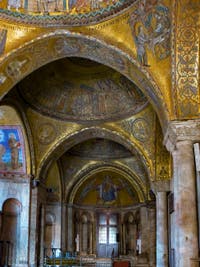
S.Mark Atrium's Mosaics A serious popular uprising started that year in Venice.
It targets the Doge Pietro IV Candiano named with the support of King of the Franks, Berangar II.
Pietro IV Candiano was also a supporter of the Germanic alliance with Otton II of Saxony.
Western influence on Venice is then in an open struggle with Eastern influence.
The uprising against Doge Pietro IV is therefore based on strategic considerations vital to the future of Venice.
But whatever the reasons for the insurrection, the fact is that the doge took refuge with his family in the Atrium of the Church of St. Mark and that he and his own people were chased and murdered there.
This insurrection, which marks the victory of the supporters of Constantinople and the election of a new anti-Germanist and pro-Byzantine Doge, Pietro I Orseolo, also coincides with the destruction of the Church of St. Mark and the Doge's Palace, both burned in fratricidal clashes.
Repairs and Reconstruction of St. Mark's Basilica
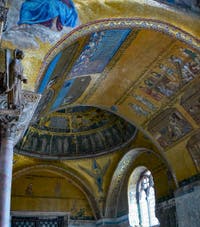
S.Mark Atrium's Mosaics The whole church has not been wholly destroyed; walls are still standing.
According to some chronicles of the time, it is indicated that much of the church, or even half of the church of St. Mark, was destroyed by fire.
The fire's damage is mainly repaired by the Doge Pietro I Orseolo but without building the church again.
1060: “Political” construction of the third St. Mark's Basilica
The date is between 1060 and 1063.However, the restoration after the fire had been completed, and there was no apparent reason for launching a new construction of St. Mark's Basilica.
Yet there was a reason, not decorative or religious, but political, for deciding to build a new basilica.
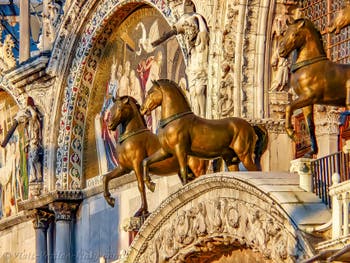
Saint-Mark Basilica's Horses In any case between the dogate of Domenico Contarini, Doge from 1042 to 1071 and that of Vitale Falier, Doge from 1086 to 1096, that the third basilica of Saint Mark is built.
This building lasted from 1060 at the end of the same century, for almost forty years.
St. Mark, Byzantine Basilica, Why a basilica “Byzantine”?
Let us remember the rivalry with Aquileia, a religious crisis that lasts for centuries but resolved in April 1053 when Pope Leo IX declared that Grado will be the “new Aquileia”, “head and metropolis of all Veneto and Istria”.It is a victory for Venice, but it is insufficient; Aquileia is defeated, but Grado is also not Venice.
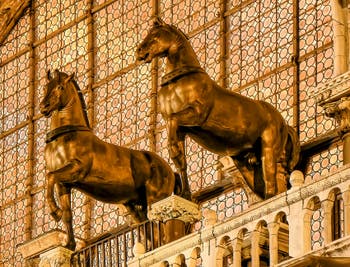
Saint-Mark Basilica's Horses Especially since Leo IX's decision is not accepted by all and that dissension persist.
At the same time, Venice also became powerful far beyond its territory, Venice, which has now definitively freed itself from the pro-Germanic Aquileia and dreams of freeing itself from the East and, therefore, from Grado.
Venice wants to quickly and definitively become sovereign and independent.
And at this time of religious fervour, Venice has a significant asset in its game to do this: The Body of Saint Mark.
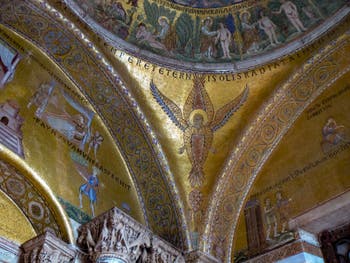
S.Mark Atrium's Mosaics Venice will therefore use this asset to create and establish its identity and independence.
And to do so, she decides to build a new basilica, even larger and glorious than the previous one, a basilica that will impose it on the world!
This political decision will totally impact the architecture of the future St. Mark's Basilica.
For Venice's political strategy to succeed, the future basilica must be as little European as possible.
And to be able to assert even more firmly its political intention, Venice decided to build a basilica that is precisely the most Byzantine possible.
St. Mark Basilica: The Temple of Divine Wisdom, the Church of the Holy Apostles
Manuscripts from the time show that the plans for the new basilica of St. Mark were designed from the Church of the Twelve Apostles in Constantinople.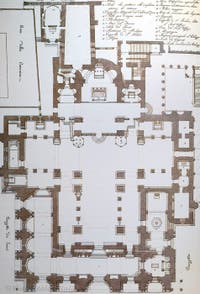
St. Mark's Plan To convince yourself, it is enough to observe the common points between the two churches, according to what we have known about this disappeared church by reading its Book of Ceremonies.
The Apostolion of the Church of the Douze Apostles was preceded by a gantry atrium, and the portion of the portico adjacent to the facade was missing.
There was a Narthex surrounding part of the western cross arm.
The church had 5 cupolas whose central was higher, and all had windows in the cylindrical drum.
We could continue this way, but we quickly see that this is almost the description of St. Mark's Basilica.
This Byzantine model, further corroborated by the manuscript of a monk from San Nicolo of the Lido, was, therefore, the basis of the new basilica of St. Mark.
St. Mark Basilica: Unique in the World
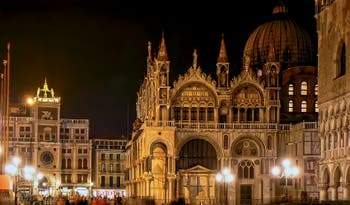
Saint-Mark Basilica Facade St. Mark is a unique basilica in the world with that of the Holy Apostles.
Venice, therefore, decides to build a basilica which, apart from its original model of the Holy Apostles in Constantinople, will have to be unique in the world.
Venice will thus assert even more its difference from the Romano-Germanic Aquileia and begin to build and embellish its myth.
And over the following centuries, Venice will be particularly good at doing this!
Consolidation of the Myth: The Apparition of October 8, 1094!
You were able to read here and there that Saint Mark's body had been lost following the fire of 976 because to avoid the worst, it was then hidden, but the truth was that it was lost.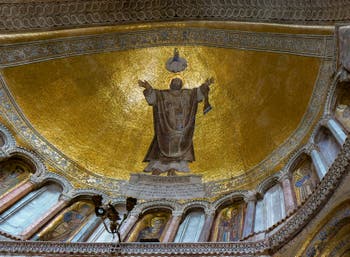
S.Mark Atrium's Mosaics To fully understand the foundations of this apparition, one must know that on October 8, during the reconstruction of the church of Constantine VII Porphyrogenitus, the body of Saint Luke, another evangelist, had miraculously been found in the Apostolion.
And for all, it was indeed an “Apparitio”, an apparition, a miracle!
So not only did Venice decide for this new basilica to reproduce the architectural form of the Apostolion, but it could be proud of having also had a saint as miraculous as St Luke.
Indeed, it was on the very day of the consecration of the new basilica of St. Mark, on October 8, that the body of the evangelist Saint Mark made its apparition.
Art Story Saint Mark's Body | History | Byzantine | Domes and Horses
Saint-Mark Art Story | Location | Opening Hours Tickets | Authorizations
Churches Saint-Mark | Miracoli | Stefano | Zaccaria | Murano | Chorus | Mass Hours
Back to Top of Page

